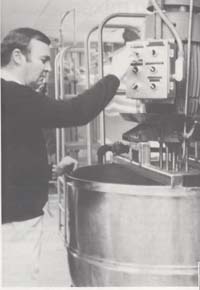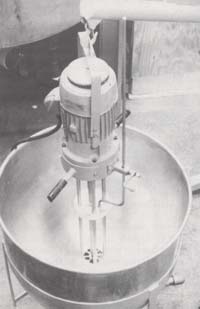Reversible Homogenizing Mixer Blends Stabilizer Slurries For Fruit-Based Sauces
Smooth mixing eliminates lumping, increases output 25%
Top quality fruit-based sauces, fillings, and toppings for food service and industrial markets are processed at the Clovis, CA, plant of Lyons Magnus. The company grows its own fruit, including apricots, peaches, strawberries, and several varieties of bush berries. The food specialty products are hot packed in No. 2 No.5 and No. 10 cans, or aseptically processed for packing in 1, 5, and 55-gallon containers.
Packing procedures start with pre-mixing of a stabilizer slurry to be blended with the fruit ingredients. Depending on product formulation, stabilizers such as pectin, carboxy methyl cellulose, xanthan gum, and starches may be used. The stabilizers are mixed with water, sugar syrup, fruit juice, fruit puree, or a combination of these liquids. Rapid and uniform blending of the stabilizer slurry is important.
Problem: The finely powdered stabilizers are difficult to disperse in the liquid base. They are hard to wet and tend to clump together during mixing. Several different types of mixers were tried to prevent this problem, including marine prop mixers, turbine agitators, and pump type continuous mixers. All of them left unacceptable lumps in the product. Changes in procedure also were evaluated. Extending the batch mixing time was successful in removing the lumps, but made the mixture too thick, causing motor breakdowns due to overload. Filtering of the stabilizer slurry also was tried, but the sticky lumps tended to clog the filters and were difficult to remove. Batch preparation times were too long and product losses unacceptably high.
Solution: A reversible homogenizing mixture was installed in a 150-gallon capacity jacketed kettle. This type of mixer works like a submersible pump. In a downward "vortex" mode, the rotor sucks the product down into the mixing head. Product is subjected to a combination of intense mechanical force and hydraulic shear. It leaves the mixing head as a high velocity stream, sweeps across the bottom of the tank, and rises back up along the tank wall. As the stream reaches the surface, it forms a wave that rolls back to the center. The result is rapid and effective blending of the product.
The Model C-2 Reversible Homogenizing mixer used at Lyons Magnus has a 33" immersion length and is mounted so that the tip of the mixing head is about 4" from the bottom of the kettle. A multi bladed 5" dia rotor turns at 3600 RPM inside a double stator mixing head. The homogenizer prepares 40 to 100-gallon batches of stabilizer slurry. Twenty to 40 lb. of stabilizers are added to the liquid base with the mixer turned on in downward "vortex" operating mode. The fine powders are immediately pulled into the fast flowing liquid. Blending of ingredients typically takes only 2 to 5 minutes. The mixer continues to operate in downward mode for an additional 2 to 3 minutes or, when required, it can be reversed to upward "umbrella" flow mode for very intense and rapid mixing action. The mixer is then shut off and the slurry is pumped to the fruit blending station. The finished slurry is uniformly smooth and lump free, with a viscosity ranging from 10,000 to 40,000 cps. Small pieces of fruit are gently mixed into the prepared slurry, using a slow speed ribbon blender. Then the mixture is pumped through two scraped surface heat exchanges operating in tandem. The first heats the product to the desired temperature (200 F); the second rapidly cools it down to the filling temperature. Rapid processing and cooling help to preserve the natural color and the flavor of delicate fruit-based products.
Results: Batches of stabilizer slurry are now prepared quickly and smoothly in the reversible homogenizing mixer. Each batch is uniform throughout, without lumps or agglomerates. It is no longer necessary to strain or filter the slurry, thereby saving production time and eliminating product loss.
Up to 25 batches/day of slurry can be prepared with the homogenizing mixer, vs. 20 batches/day with a conventional mixer. This amounts to a 25% increase in productivity with no increase in operating labor.
Successful use of the new mixer led to purchase of two additional units for other production lines at Lyons Magnus. A fourth mixer has also been installed to blend hard-to-wet cocoa powder with sugar syrup.
Reprinted from August 1984 Food Processing Magazine